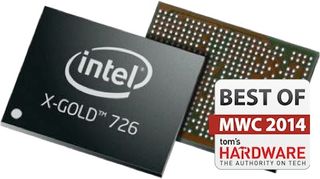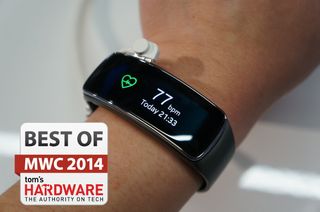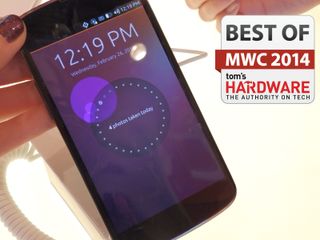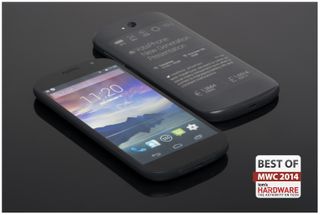Tom's Hardware Best Of Mobile World Congress 2014 Awards
We covered a ton of upcoming products and technologies at this year’s Mobile World Congress in Barcelona. With the trade show officially drawn to a close, we’ve had a chance to discuss the various reveals and select our picks for the Best Of MWC 2014.
The Best of Mobile World Congress 2014

The Mobile World Congress (MWC) in beautiful Barcelona, Spain is the trade show for any company involved in the mobile market. We caught a glimpse of what to expect in the year ahead at MWC 2014. While most of the big names in smartphones and tablets seem to be taking a more, shall we say...evolutionary approach to their handsets, some of the companies in attendance dared to do something different, and that set the tone for our top picks. This year, the focus of our Best Of MWC 2014 awards is on the products and technologies that captured our attention amongst a sea of iterating.
The following seven reveals made the cut because they promise to shake up, redefine, diversify, or improve the current mobile landscape.
Intel XMM 7260 LTE-Advanced Modem

The Intel XMM 7260 LTE-Advanced modem could possibly give the chip giant the serious wedge it needs to get x86 into mobility.
The hardware supports up to CAT 6 at 300 Mb/s and Carrier Aggregation up to 40 MHz. Due to the simplified two-chip design, Carrier Aggregation is achieved entirely within one chip, thus saving power, as fewer chips need to be engaged at the same time while aggregated LTE segments switch in and out.
Supporting over 30 bands, to cover every country currently employing LTE technology, the XMM 7260 appears to be a truly global solution. What’s more, up to 22 of these bands can be used simultaneously, which means that switching between bands should be seamless - a key factor for globetrotters, as there would be no more need to carry a different device for every region.
The XMM 7260 presents a serious effort from Intel to compete in the mobile space, and that's why it earned a spot on our Best Of MWC 2014 list.
Samsung Galaxy Gear Fit

We were pretty surprised when Samsung announced not one refreshed Galaxy Gear, but three. While two of these models are largely the same, the Gear Fit stands alone as a separate product. Aimed at fitness fanatics, the Gear Fit displays data from a built-in heart monitor, and can be used to track your sleep patterns and exercise routine.
Stay on the Cutting Edge
Join the experts who read Tom's Hardware for the inside track on enthusiast PC tech news — and have for over 25 years. We'll send breaking news and in-depth reviews of CPUs, GPUs, AI, maker hardware and more straight to your inbox.
While that's cool and all, it's not the reason we’re recognizing the Samsung Galaxy Gear Fit. We’re giving the Gear Fit a Best Of MWC 2014 award because it's the first smartwatch that we honestly wouldn't mind wearing every day. One of our biggest problems with the original Gear was that it was kind of big and ungainly-looking. The Gear Fit, with its curved 1.83-inch 432x128 AMOLED panel is a lot easier on the eye.
SanDisk 128 GB microSDXC Card

At this year’s MWC, SanDisk revealed an entirely new 128 GB microSDXC card – that’s 64 gigabytes bigger than any other microSDXC card currently on the market. Granted, flash storage capacity always doubles at each new tier, but 128 GB of storage that's no bigger than your fingernail is nonetheless a significant achievement. To put it into perspective, the microSD format launched with a 128 megabyte card less than ten years ago, and now nearly a decade later, we have a thousand times greater storage capacity inside the same form factor.
To enable 128 GB of storage on a removable microSD card, SanDisk developed an innovative proprietary technique where 16 memory dies, each shaved to be thinner than a single strand of hair, are stacked on top of each other.
Thanks to smartphone manufacturers who support microSD expansion cards in their devices, some consumers will no longer have to make the tough decision on which storage size to buy. With the SanDisk Ultra microSDXC card, they can simply drop more in – now up to 128 GB more.
Ubuntu For Phones

Canonical has been working on its smartphone operating system for a while now. The company first showed off its mobile version of Ubuntu running on a Galaxy Nexus at CES 2013. The OS was shown running on slightly updated hardware, a Nexus 4, at this year’s MWC. Overall, the experience was a lot smoother, and the operating system itself was a pleasure to use, being both intuitive and visually appealing.
We're eager to get our hands on some new phones running this software, and luckily, we don't actually have all that long to wait. Just last week Canonical announced that both Meizu and BQ had signed on to produce and release Ubuntu-based smartphones. In fact, we already went hands-on with the first of Meizu's Ubuntu offerings, and while our MX3 is running Android, an Ubuntu-flavored handset is due to hit the States later this year.
Boasting a 5.2-inch 1800x1080 display (412 ppi), the MX3 also packs an Exynos 5 Octa SoC, 2 GB of RAM, and an integrated 2400 mAh battery. The handset also features an 8-megapixel rear camera, with a 2-megapixel lens up front, and both cameras can shoot 1080p video at 30 frames per second. While the MX3 isn’t as attractive as the Ubuntu Edge that Canonical initially tried to launch via Indiegogo, it is a bit more powerful than the current Nexus 4 reference unit.
Ubuntu presents a fresh take on the smartphone OS, and that’s why we’re giving it our Best Of MWC 2014.
Roamer

As part of our preparations for MWC, we were going to acquire some foreign SIM cards. That is, until we learned about a solution called Roamer from a UK-based startup. Roamer ensures that you don't miss any calls to your home number while abroad by acting as an extra layer on top of any foreign SIM. Being able to take calls to one's home number is especially important for business travelers.
Roamer has made the process exceedingly simple through its app, which is currently available on both iOS and Android. The app acts as an interface for sending GSM codes to your carrier, forwarding your number to a local one so that you don't incur any international calling charges. Behind the scenes, Roamer actually routes your calls through a more complex series of forwarding so that it can arrive transparently to your foreign mobile. It also works for outgoing calls, and your caller ID remains the same, so people on the other end of the line won't even be able to tell that you're out of the country.
It's a clever system that made our visit in Barcelona a better one, and that's why we’re giving Roamer our Best Of MWC 2014 award.
YotaPhone Second Generation

YotaPhone was one of the most high-profile devices at MWC this year. Yota Devices, the company responsible for the YotaPhone, made headlines in December when it announced the first generation of the device. Now, just three months later, the company is already introducing the next generation. Although announced so soon after the original, YotaPhone 2 is a quite different device. It adds capacitive touch to the rear display, and ditches some of the features that puzzled us with the first iteration, namely the lack of home, back, and task switcher keys, and bizarre camera placement.
Yota Devices says the changes are based on feedback from many different sources. Speaking about the unveiling of the second YotaPhone, Yota Devices CEO Vlad Martynov said: "The Android community, along with our partners, suppliers and retailers, love our dual-screen, always-on concept and have many great suggestions for taking it to the next level." The YotaPhone 2 won't be out until the fourth quarter of this year, so anyone hoping to buy one will have to wait a while, or make do with the old version.
Besides the product’s obvious uniqueness, the smarter design of the next generation YotaPhone was a direct result of a company incorporating community feedback, and so the YotaPhone 2 receives our final Best Of MWC 2014 award.
Follow Jane, Marcus, and Tom's Hardware on Twitter.
-
jasonelmore I wonder what kind of battery life that XOMA phone gets with 2 LCD screens sandwiched together.Reply -
shahrooz DudeReplyI wonder what kind of battery life that XOMA phone gets with 2 LCD screens sandwiched together.
E-ink displays don't consume battery while displaying static images. They are far more efficient than lcd. As the producer said you can use this for some days off you get used to using eink display more than the other one -
adibo The samsung gear fit is more a bracelet than a watch unlike the Galaxy Gear, plus it is more elegant, beautiful accessories for galaxy s5, I wonder if it work with galaxy s4 and galaxy s3Reply
Most Popular





